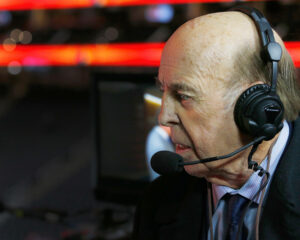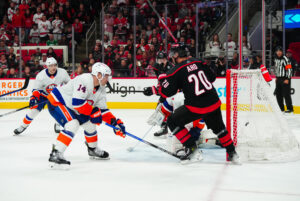For many reasons, overtime in playoff hockey is exhilarating. It’s the ultimate do-or-die stretch in sports, and when it comes to the Stanley Cup Playoffs, overtime is must-watch.
For both involved teams and their fanbases, overtime stress levels are obviously amped up. These emotions increase even more when a man advantage occurs. A penalty can be a death wish for a team who’s opponent is seeking an opportunity, as TSN once pointed out.
A flagship example of nerve-wracking power plays in overtime is in the 2013 Eastern Conference Final. In double overtime of Game 3, the Boston Bruins took a too many men penalty to give the Pittsburgh Penguins a man advantage. Pittsburgh coach Dan Bylsma then put out his power-play one unit of Evgeni Malkin, Sidney Crosby, James Neal, Kris Letang, and Chris Kunitz — five players who could’ve ended the game pronto.
The Penguins didn’t score and Boston went on to win the game, but still a hair-raising moment for the Bruins.
Power Play Success in Stanley Cup Playoffs Overtime Drops From Regular-Season, Regulation Power Plays
Over the past five NHL seasons, the average team’s regular-season power play has converted at a rate of about 19.4-percent. In the past five Stanley Cup Playoffs, that percentage slightly raises up to about 19.56-percent. When it comes to overtime power plays in the past five Stanley Cup Playoffs, the success rate dips to 15.9-percent.
There have been 44 overtime-power plays in the past five Stanley Cup Playoffs. Seven times has an overtime ended with a team on a man advantage.
Forty-four power plays is no small sample size, so what gives? There’s no concrete answer, but the intensity of the moment could slightly throw off a power play’s execution. Or penalty killers may find that extra ounce of effort given the do-or-die situation. Or, of course, it is all uncorrelated and power-play success in certain moments is random.
But at the end of the day, the past five Stanley Cup Playoffs show that overtime power plays don’t click at as high of a rate of regular-season and regulation-time power plays.
2014–15 Playoffs: O-fer in OT
The 2014–15 Stanley Cup Playoffs featured nine overtime power plays, and zero power-play game-winners. The Chicago Blackhawks led the way with five power-play opportunities, but could not capitalize on any. They still won the cup, so not a big problem.
The 2014–15 regular-season power-play average was 18.66 percent, while the playoff average jumped to 19.03. The playoff overtime average was 0 percent, as said.
2015–16 Playoffs: Converting on Chances
The 2015–16 Stanley Cup Playoffs had a better fate with overtime power plays. Two of eight man advantages ended in game-winners. New York Islanders forward Alan Quine scored one of his 11 career NHL goals during five-on-four play in an extra period, while former St. Louis Blues captain David Backes converted on a Blues’ overtime power play in the Second Round. The Nashville Predators had the most chances with two.
A 25 percent league overtime power-play percentage was much better than the 18.66 percentage during the regular season. Throughout the playoffs, the rate was 19.36.
2016–17 Playoffs: Ottawa’s First-Round Conversions
The Ottawa Senators made the most of their overtime power plays in the 2016–17 playoffs, but other teams couldn’t say the same. The Sens won two of their First Round games over the Boston Bruins in overtime, thanks to goals from Bobby Ryan and Clarke MacArthur, the latter a series winner. Elsewhere it was Washington Capitals defenceman Kevin Shattenkirk playing hero while his team was playing five-on-four.
A 21.4 playoff power-play percentage was again better than the league average during the regular season, which was 19.1, and the playoff average which was even lower at 16.91
2017–18 Playoffs: The Caps Year
The 2017–18 playoffs were centred around the Caps finally getting the job done, as well s the emergence of the Vegas Golden Knights. In their inaugural season and cup run, Vegas got the most overtime power plays with three, but converted on zero. In fact, the Golden Knights were the victim of the only power-play overtime-winner which come off the stick of San Jose Sharks forward Logan Couture.
A 14.28-overtime power-play percentage was much lower than the regular season, which saw teams converting at a 20.18 rate. It was also no coincidence that the playoff power-play average was 22.79-percent in a season in which Washington won the cup.
2018–19 Playoffs: Lack of Overtimes
Last year’s Stanley Cup Playoffs featured just six overtime-power plays, a low through the past five years. Columbus Blue Jackets forward Matt Duchene scored the only overtime winner while on a power-play, defeating the Bruins in a Second Round contest. No team got more than two power plays during overtime periods.
The 16.67-perecent power-play conversion rate in overtime was slightly higher than the average over the past five seasons. It was still significantly lower than the regular season, which was 19.78, and the playoffs overall, which went up a smidge to 19.81.
Current Playoffs: Opportunities Incoming
Going into August 30’s slate of games, the 2019–20 Stanley Cup Playoffs have been full of power plays. The first 100 postseason games, including the qualifying round, featured 7.07 power plays per game. That’s the highest average from the last five Stanley Cup Playoffs.
As for overtime power plays, 2019–20 sits exactly as 2018–19: one game-winner on six power-play attempts. Toronto Maple Leafs star Auston Matthews has the lone tally, coming in the Leafs’ epic comeback in Game 4 of the qualifying round.
As for the entire playoffs, teams are scoring on power plays at a 18.67 rate. While slightly higher than recent years, it’s lower than the 20.03 percentage during the regular season.
Main photo:






